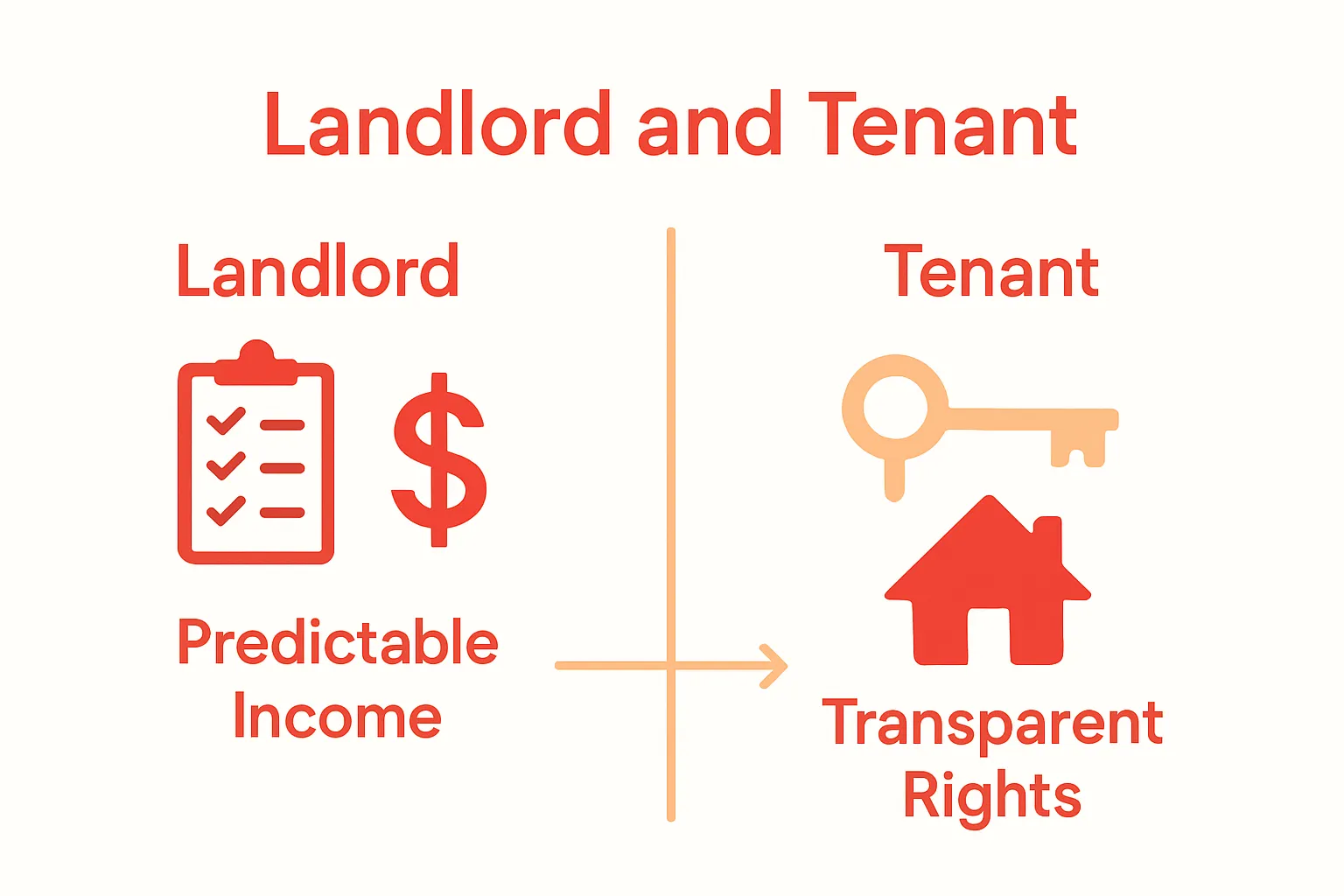A lease shapes nearly every rented property in the UK, quietly steering a property market worth over £1.5 trillion. Many expect these agreements to be little more than dull paperwork. The reality is, a single overlooked line in a lease can decide who is liable for thousands of pounds in repairs or even lead to eviction. Most tenants and owners never spot the catch until it is too late.
Table of Contents
- Defining A Lease: The Basics And Terminology
- The Importance Of Leases For Property Owners
- How Leases Function In Real Property Transactions
- Key Concepts And Terms In Leasing Agreements
- Understanding Your Responsibilities As A Lessor
Quick Summary
| Takeaway | Explanation |
|---|---|
| Understand the lease components | Familiarise yourself with duration, rental amount, and maintenance responsibilities to ensure clarity in agreements. |
| Leases provide financial security | Clear terms in a lease guarantee regular payments and establish predictable income streams for property owners. |
| Legal protections in leases | Leases protect both parties by outlining expectations, reducing disputes, and specifying recourse in case of issues. |
| Lessor responsibilities are comprehensive | Lessors must maintain habitable conditions and comply with health and safety regulations to ensure tenant well-being. |
| Know essential lease terminology | Understanding key terms, such as security deposits and termination clauses, is vital for effective lease agreements. |
Defining a Lease: The Basics and Terminology
A lease represents a fundamental legal agreement that governs the relationship between a property owner and a tenant, establishing clear parameters for property usage and financial obligations. According to Cornell Law School, a lease is a contractual document that transfers specific property rights for a predetermined period.
What Exactly Is a Lease?
At its core, a lease is a legally binding contract where one party (the lessor or property owner) grants another party (the lessee or tenant) the right to use a specific property in exchange for regular monetary payments. This agreement outlines precise terms including duration, financial commitments, responsibilities, and conditions of property use.
Key components of a standard lease typically include:
- Duration of occupancy
- Monthly rental amount
- Security deposit requirements
- Maintenance responsibilities
- Conditions for termination
Legal and Financial Implications
Leases serve multiple critical functions beyond simple property access. They provide legal protections for both property owners and tenants by clearly defining expectations and potential recourses.
 As Investopedia explains, these agreements establish a structured framework that minimizes potential disputes and provides clarity on financial and usage obligations.
As Investopedia explains, these agreements establish a structured framework that minimizes potential disputes and provides clarity on financial and usage obligations.
Property owners benefit from leases by securing predictable income streams and establishing formal boundaries for property usage. Tenants gain the advantage of structured living arrangements with defined rights and responsibilities, creating a transparent and secure housing environment.
Understanding the nuanced terminology and legal implications of a lease is crucial for both property owners and potential tenants, ensuring a mutual understanding that protects the interests of all parties involved.
The Importance of Leases for Property Owners
Leases represent far more than simple legal documents for property owners they are strategic tools for financial management, risk mitigation, and long-term property investment protection. According to the National Association of Residential Property Managers, a comprehensive lease serves multiple critical functions beyond basic property rental.
Financial Security and Predictable Income
For property owners, leases are fundamental mechanisms for generating consistent and predictable revenue streams. By establishing clear financial terms, leases transform property ownership from an uncertain investment into a structured income-generating asset. Formal lease agreements ensure regular monthly payments, protecting owners from potential income disruptions and providing a reliable financial foundation.
Key financial advantages of robust leases include:
- Predetermined rental rates
- Guaranteed payment schedules
- Clear mechanisms for rent adjustments
- Defined consequences for payment defaults
- Protection against unexpected vacancies
Legal Protection and Risk Mitigation
Leases function as critical legal shields for property owners, outlining precise expectations and responsibilities for both parties. Research from the American Apartment Owners Association highlights that well-constructed lease agreements can significantly reduce potential legal disputes and provide clear recourse in challenging tenant situations.
A comprehensive lease helps property owners manage risks by:
- Establishing clear property usage guidelines
- Defining maintenance responsibilities
- Specifying grounds for lease termination
- Protecting against potential property damage
- Creating transparent communication frameworks
By meticulously crafting lease agreements, property owners transform potential vulnerabilities into structured, manageable relationships that protect their financial interests and property investments. The lease becomes not just a document, but a strategic tool for sustainable property management.
The table below summarises the main financial and legal advantages a lease provides to property owners, helping to highlight the strategic importance of formal lease agreements.
| Advantage | Financial Benefit | Legal/Protection Benefit |
|---|---|---|
| Predictable Income | Assured rental payments and schedules | Reduces risk of non-payment disputes |
| Rental Rate Stability | Predetermined rates over the lease term | Safeguards against abrupt rent increases or challenges |
| Defined Responsibilities | Clear maintenance cost allocation | Minimises liability through explicit duty definitions |
| Vacancy Protection | Reduces unexpected revenue loss | Sets formal notice periods for tenant departure |
| Legal Recourse Framework | Specifies consequences for defaults | Enables enforcement of remedies for breaches |
| Property Usage Guidelines | Limits misuse that could incur costly repairs | Protects owner from unauthorised activities |
How Leases Function in Real Property Transactions
Real property transactions involving leases represent complex legal and financial interactions that go beyond simple property rental. According to legal experts at Nolo, a lease creates a specific legal framework that defines the rights and obligations of both property owners and tenants.
The Mechanics of Leasehold Interests
A leasehold interest is a unique legal construct that grants tenants temporary property rights without transferring actual ownership. This mechanism allows individuals to occupy and use property for a predetermined period while the property owner retains ultimate ownership. The lease document serves as the critical mechanism defining the scope, duration, and specific conditions of this temporary property access.
Key characteristics of leasehold interests include:
- Time-limited property usage rights
- Defined financial obligations
- Specific boundaries of permissible property use
- Explicit conditions for occupancy
- Mechanisms for potential lease renewal or termination
Transaction Structures and Legal Frameworks
Leases operate within a sophisticated legal ecosystem that balances the interests of property owners and tenants. These agreements are not merely transactional documents but complex legal instruments that establish comprehensive guidelines for property interaction.
The transaction typically involves several critical elements:
- Formal written agreement detailing all terms
- Specification of rental payments and schedules
- Clear delineation of maintenance responsibilities
- Provisions for potential dispute resolution
- Explicit description of property conditions at transfer
By creating a structured, legally binding framework, leases transform potential property conflicts into predictable, manageable interactions. They provide a transparent mechanism for property access that protects the interests of both parties while facilitating flexible, efficient real estate utilisation.
Key Concepts and Terms in Leasing Agreements
Leasing agreements represent sophisticated legal documents with complex terminology that defines the intricate relationship between property owners and tenants. According to Cornell Law School, understanding these terms is crucial for establishing clear expectations and legal protections for both parties.
Essential Parties and Roles
Lease agreements fundamentally define the roles and responsibilities of two primary parties: the lessor (property owner) and the lessee (tenant). These terms establish a clear legal framework that outlines each party’s specific rights, obligations, and potential recourses in various scenarios.
Key roles and their fundamental characteristics include:
- Lessor: Property owner who grants usage rights
- Lessee: Individual or entity receiving property usage rights
- Property manager: Optional intermediary managing rental interactions
- Co-signers: Additional parties accepting financial responsibility
Critical Lease Terminology
The language of lease agreements contains specific technical terms that carry significant legal implications. Understanding these terms is essential for preventing misunderstandings and potential disputes. Each term represents a precise legal concept that defines the parameters of the property transaction.
Fundamental lease terminology encompasses:
- Rental period
- Security deposit
- Fair wear and tear
- Subletting provisions
- Termination clauses
- Breach of contract conditions
By comprehensively understanding these terms, property owners and tenants can create transparent, mutually beneficial agreements that protect both parties’ interests while establishing clear expectations for property usage and financial obligations.
To clarify the most important terminology found in lease agreements, the following table offers concise definitions of key terms referenced throughout the article.
| Term | Definition |
|---|---|
| Lessor | The property owner who grants the right to use the property to another party. |
| Lessee | The tenant or individual/entity granted usage rights to occupy the property. |
| Leasehold Interest | The tenant’s legal right to occupy and use the property for a predetermined period. |
| Security Deposit | Money held by the lessor as security against potential damages or unpaid rent. |
| Termination Clause | A contractual provision outlining the conditions under which the lease may end early. |
| Fair Wear and Tear | Reasonable deterioration from normal use that the tenant is not responsible for repairing. |
| Subletting Provision | Terms stating whether and how the lessee may rent the property to someone else. |
| Breach of Contract | A situation where one party fails to fulfil their legal obligations under the lease agreement. |
Understanding Your Responsibilities as a Lessor
The role of a lessor extends far beyond merely collecting rent and owning property. According to Cornell Law School, lessors have comprehensive legal and ethical obligations that ensure tenant safety, property maintenance, and compliance with local housing regulations.
Legal and Ethical Property Maintenance
Lessors are legally required to provide habitable living conditions that meet fundamental health and safety standards. This responsibility encompasses more than basic structural integrity it involves creating an environment that supports tenant well-being and peaceful enjoyment of the leased property.
Critical maintenance responsibilities include:
- Ensuring structural soundness of the property
- Maintaining functional plumbing and electrical systems
- Addressing potential safety hazards
- Providing adequate heating and cooling
- Preventing pest infestations
- Responding promptly to maintenance requests
Financial and Administrative Obligations
Beyond physical property maintenance, lessors have significant financial and administrative responsibilities that protect both their investment and the tenant’s rights. These obligations create a transparent, legally compliant framework for property rental.
Key administrative and financial responsibilities encompass:
- Accurate documentation of lease terms
- Proper handling of security deposits
- Transparent communication of rental policies
- Compliance with local rental regulations
- Fair and consistent application of lease terms
- Maintaining appropriate insurance coverage
By understanding and proactively managing these responsibilities, lessors can create positive, legally sound rental relationships that protect their property investments while providing tenants with secure, comfortable living environments.

Take the Uncertainty out of Leasing with Guestly Homes
You have seen how leases are the backbone of property management, defining everything from stable income to risk protection. Yet, creating the right agreement and managing all the moving parts can be stressful for any property owner. If you are looking for predictable income, trustworthy management, and peace of mind, Guestly Homes turns the legal complexity of leasing into frictionless performance.

Switch from tenant headaches and unfulfilled promises to true partnership. Guestly Homes offers structured models including long-term leases and revenue sharing so that your property is always in safe hands. Discover how our proven approach to fully managed homes delivers both legal clarity and superior results by visiting Guestly Homes now. Your next worry-free lease starts with a single click.
Frequently Asked Questions
What is a lease?
A lease is a legally binding contract between a property owner (lessor) and a tenant (lessee) that allows the tenant to use the property in exchange for regular payments, outlining terms like duration, financial obligations, and responsibilities.
What are the key components of a standard lease agreement?
A standard lease agreement typically includes the duration of occupancy, monthly rental amount, security deposit requirements, maintenance responsibilities, and conditions for termination.
How do leases provide legal protection for property owners?
Leases establish clear expectations and responsibilities for both parties, minimising disputes by defining property usage guidelines, maintenance responsibilities, and grounds for termination, thus protecting property owners from legal issues.
What responsibilities do lessors have towards their tenants?
Lessors must provide habitable living conditions, which include maintaining the property’s structure, functionality of essential systems, and addressing safety hazards, as well as handling security deposits and ensuring compliance with rental regulations.



